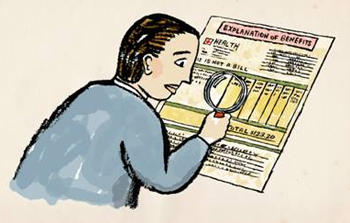News and Notes from The Johnson Center
Explaining the Explanation of Benefits Form
JCCHD | Thu, June 04, 2015 |How on earth do you read an EXPLANATION OF BENEFITS statement? In our webinar, NAVIGATING INSURANCE, we discussed the Explanation of Benefits (EOB) document provided by your insurance company. The document outlines how benefits were paid out for a specific claim. For in-network services, the EOB will arrive after your care provider has processed your claim. The EOB explains the charges, what the insurance company paid, what they denied (and why), and if you should expect to have an outstanding bill with the provider. It is important to remember that you do not pay the EOB, it is a statement, not a bill.

For out-of-network services, you will most likely pay your clinician at the time of service (unless other arrangements have been made). Once you submit your receipt showing what you paid and a completed claim form to your insurance company, they will send you an EOB. The EOB will arrive with a reimbursement check or a statement explaining the reason they are denying reimbursement.
It’s important to double-check that the information on the EOB is correct. Be sure to check the following:
• The date of service
• CPT code
• The amount allowed for the appointment
• Any amount applied to your deductible
• Any co-pay reported
• What, if anything, they paid directly to your provider
• The patient’s responsibility (amount they have determined you owe)
The notes section will list the reason for the amount of your reimbursement check or the reason for the denial of reimbursement. Often the explanation for denial of services is one that you can appeal; for example, it may state something like: *charges for speech therapy are only covered when therapy is expected to restore speech function or correct a speech impairment from non-chronic conditions, acute illnesses, or injury…
An appeal is typically a one-page form that your carrier will provide. You can send it in with notes from your therapist or clinician to support your claim that your insurance policy should cover the service. This is the point when you will be happy you took such detailed notes while on the phone with your insurance company [download our Insurance Call Worksheet here]. In the event that the denial is for a reason you were previously told was covered, you will have documented all the important information. You can use this, including the call reference numbers, to whom you spoke, services they promised, etc., in any appeal information you submit.
Even if the representative told you up front that this was not a covered service, you may still appeal with your clinician’s support and documentation. Insurance companies will typically send the appeal to a review team and will return with a decision, typically within 30 business days. Preparing and lodging an appeal can be fairly quick and it never hurts to be a squeaky wheel with insurance companies!



